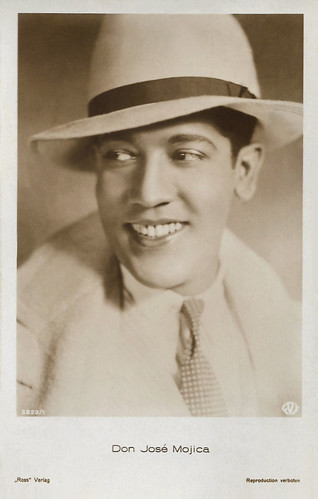
German postcard by Ross Verlag, no. 5822/1, 1930-1931. Photo: Fox.
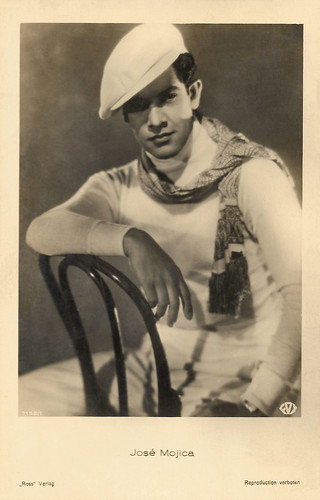
German postcard by Ross Verlag, no. 7152/1, 1932-1933. Photo: Fox.
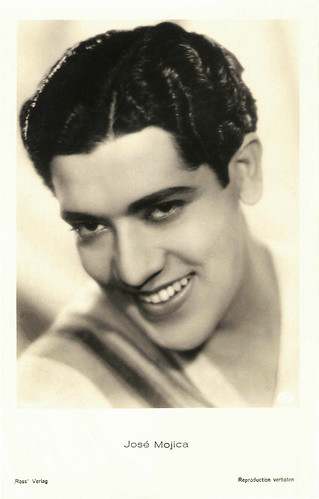
German postcard by Ross Verlag, no. 7422/1, 1932-1933. Photo: Fox.
To New York with $500 in his pocket
José Mojica was born Crescenciano Abel Exaltación de la Cruz José de Jesus Mojica Montenegro y Chavarín in 1896 in San Gabriel, Jalisco, Mexico. Mojica was raised in a coffee and sugar plantation community until the age of six after his stepfather Francisco died. He never knew his real father.
When his mother's extended family suffered financial challenges, they moved with limited means to Mexico City where he studied at the Academy of San Carlos and later attended the National School of Agriculture.
He initially planned for a career in engineering, but changed his mind and studied singing at the National Conservatory of Music. In 1916 he debuted at the Teatro Arbeu, playing the Count Almaviva role in Gioachino Rossini's opera 'The Barber of Seville'. The following year, he performed the role of Rodrigo in Giuseppe Verdi's 'Otello'.
Funded by his mother, he went to New York with $500 in his pocket, attending performances of Enrico Caruso. Caruso, having met Mojica in 1919, was sufficiently impressed by his singing to help him obtain a contract with the Chicago Civic Opera Company. He debuted that same year with the minor role of Lord Arthur Bucklaw in Gaetano Donizetti's 'Lucia di Lammermoor', an opera loosely based upon Sir Walter Scott's historical novel 'The Bride of Lammermoor'.
Mojica was soon given leads opposite Mary Garden and Amelita Galli-Curci when playing leading parts in Claude Debussy´s 'Pelléas et Mélisande' and Sergej Prokofiev's 'The Love for Three Oranges'. José Mojica also recorded for Edison in 1920, 1925 and 1926.
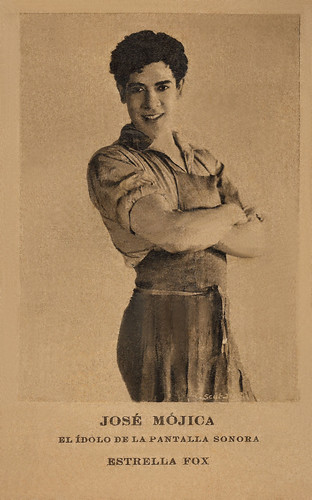
Spanish card. Photo: Fox. José Mojica in Cuando el amor ríe/When Love Laughs (David Howard, Manuel París, William J. Scully, 1930). Caption: José Mojica, The idol of the sound screen, Fox star. The film was released in Spain as Ladrón de amor.

Spanish postcard, no. 34. Photo: Fox. Caption: El idolo de la pantalla sonora, Estrella Fox. (The idol of the sound screen, Fox star).

Spanish collectors card, no. 29. Photo: Fox Film. Mona Maris, José Mojica and René Cardona in Cuando el amor ríe/When Love Laughs (David Howard, Manuel París, William J. Scully, 1930). The Spanish release title was Ladron de amor.
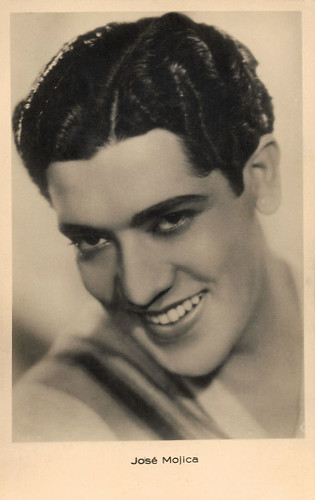
Vintage postcard.
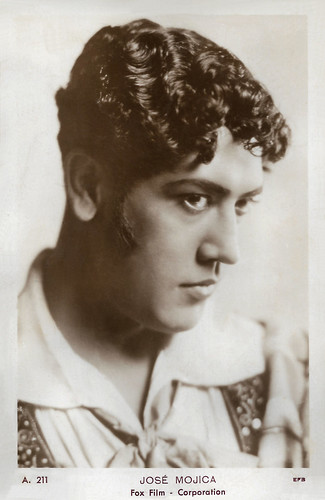
Spanish postcard by EFB (Editorial Fotográfica, Barcelona), no. A 211. Photo: Fox. Sent by mail in 1932.
A tendency to overact
Signed by Fox in 1930, José Mojica moved to California and appeared as a Spanish outlaw in the romantic musical One Mad Kiss (Marcel Silver, James Tinling, 1930), co-starring Argentine actress Mona Maris.
I.S. Mowis at IMDb: "Though he lacked neither charm nor a good voice, his popular appeal was limited by a square jaw, a stocky figure and a rather broad nose - worse, he had a tendency to overact. Fox, as a result, dropped Mojica from their 'A-list'." He starred in a series of Spanish-language romances and adventures for the next three years, often alongside Maris, Conchita Montenegro or Rosita Moreno.
One of the first was Cuando El Amor Rie/When Love Laughs (David Howard, 1930). Hal Erickson at AllMovie: "Cuando el Amor Rie is one of several Spanish-language films produced in Hollywood by Fox Studios before its 1935 merger with 20th Century studios. Set in Spanish California, the story revolves around devil-may-care-singing cowboy Jose Mojica. Wandering onto the ranch property owned by Don Alvarado, Mojica offers to tame a dangerous bucking bronco. Once he's done what he promised, Mojica accepts Alvarado's invitation to likewise "tame" his employer's tempestuous daughter Mona Maris. In other words, it's South-of-the-Border Shakespeare."
His characters remained essentially the same, even including a curious impersonation of highwayman Dick Turpin in El caballero de la noche/Dick Turpin (James Tinling, 1932). Mojica made a few more films in Mexico at the end of the decade. Following the death of his mother and prompted by religious visions, he then took the unusual step of selling his worldly possessions and becoming a Franciscan monk under the name Fray Jose de Guadalupe Mojica. After his retirement, he appeared in a few films to collect money for his order, such as El Pórtico de la Gloria/The porch of glory (Rafael J. Salvia, 1953) and Seguiré Tus Pasos/I Will Follow in Your Footsteps (Alfredo B. Crevenna, 1966).
José Mojica spent the remainder of his life in seminaries and monasteries in Peru. There he died of heart trouble in 1974 in Lima, Peru at the age of 79.
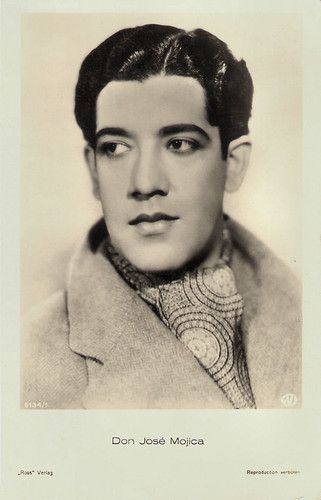
German postcard by Ross Verlag, no. 5134/1, 1930-1931. Photo: Fox.
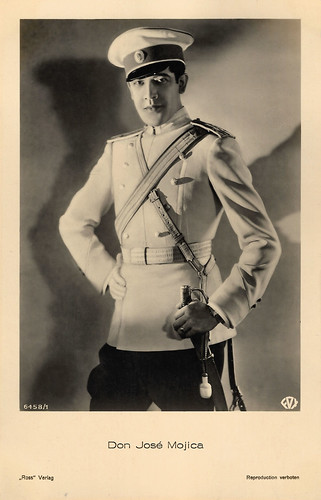
German postcard by Ross Verlag, no. 6458/1, 1931-1932. Photo: Fox.

Possibly a German-Portuguese postcard, although it may also refer to a French Ross card because of the text "Edition Ross" (but a series number conspicuously lacks). Fox. Portuguese text (translated): "From 16 May, the most sympathetic film actor-singer José Mojica, who at the Trindade presents his excellent films of Fox, will perform and sing in Spanish in 'O bandido mascarado." Cinema Trindade was and is a cinema in Porto, Portugal. The Masked Bandit may refer to Mojica's Dick Turpin film El caballero de la noche (James Tinling, 1932).
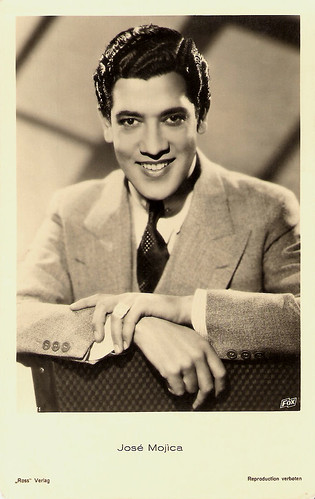
German postcard by Ross Verlag, no. 9210/1, 1935-1936. Photo: Fox.

German postard by Ross Verlag, no. A 1479/1, 1937-1938. Photo: Fox.
Sources: I.S. Mowis (IMDb), Hal Erickson (AllMovie), José L. Bernabé Tronchoni (Find A Grave), Wikipedia and IMDb.
No comments:
Post a Comment